자바스크립트 async & await
카테고리: JavaScriptJanuary 11, 2022
Async 함수와 await
자바스크립트의 async 함수는 프로미스를 좀 더 편하게 사용할 수 있도록 해주는 문법입니다. 다음의 예를 살펴봅시다:
async function fetchJsonAsync(url) {
try {
const response = await fetch(url);
return await response.json();
} catch (error) {
// error handling logic
}
}위 코드를 기존의 프로미스 방식으로 바꾸면 다음과 같습니다:
function fetchJsonViaPromise(url) {
return fetch(url)
.then(res => res.json())
.catch(error => /* error handling logic */);
}이 예제에서 볼 수 있듯, async 함수 내부에서 프로미스 기반의 코드를 마치 동기식으로 동작하는 것처럼 작성할 수 있습니다.
또한 await 키워드를 사용하여 해당 프로미스가 settle 될 때까지 async 함수의 실행을 일시 중단했다가, 이후 프로미스가 settle 되면 이전에 중단된 지점부터 다시 실행을 이어나갑니다. 이때:
- 프로미스가 fulfill 되면
await는 프로미스의 fulfillment 값을 반환합니다. - 프로미스가 reject 되면
await는 프로미스의 rejection 값을 반환합니다.
만약 프로미스가 아닌 값과 await를 사용한다면 해당 값은 resolved Promise로 변환됩니다:
async function func() {
const a = await 1;
console.log(a);
}
func(); // 1⚠️ 여기서 알아두셔야할 점은, ES2022를 기준으로 await는 반드시 async 함수 내부, 혹은 모듈의 top-level 에서만 사용할 수 있습니다. 그렇지 않으면 에러가 발생합니다:
function notAsyncFunc(url) {
// SyntaxError: await is only valid in async functions
// and the top level bodies of modules
const response = await fetch(url);
// ...
}// valid syntax
const data = fetch('some url')
.then(res => res.json());
export default await data;async 함수는 항상 프로미스를 리턴합니다. 만약 리턴값이 프로미스가 아닌 경우 암묵적으로 프로미스 객체로 변환된 후 리턴됩니다:
async function func() {
return 1;
}
func().then(val => console.log(val)); // 1
async function func2() {
throw new Error('errrrrr!');
}
func2().catch(err => console.log(err)); // Error: errrrrr!Async 함수의 동작 원리
다음 코드를 살펴봅시다:
const myPromise1 = () => Promise.resolve('myPromise1');
const myPromise2 = () => Promise.resolve('myPromise2');
async function func() {
console.log('func start');
const res1 = await myPromise1();
console.log(res1);
const res2 = await myPromise2();
console.log(res2);
console.log('func end');
}
console.log('before func');
func();
console.log('after func');위 코드의 결과는 다음과 같습니다:
before func
func start
after func
myPromise1
myPromise2
func end왜 이러한 결과가 나오는지 한번 알아봅시다.
우선, 자바스크립트 엔진이 console.log('before func');을 보고 이 함수를 콜스택에 추가하여 실행한 뒤, 다시 콜스택에서 제거합니다:
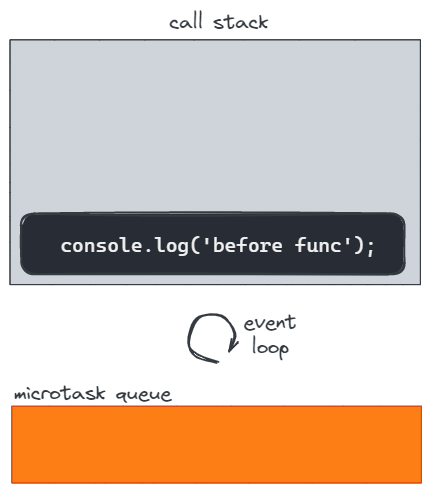
그 다음, func() 함수를 콜스택에 추가한 후 실행합니다. 이후 func() 안에 있는 console.log('func start')를 콜스택에 추가하여 실행하고, 실행 후 다시 콜스택에서 제거합니다:
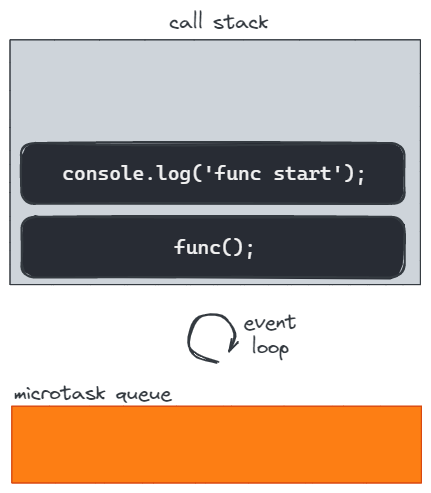
이후 자바스크립트 엔진이 await 키워드를 보고서는 대기(await)의 대상이 되는 값을 실행합니다. 이 경우 myPromise1()이 되겠죠!
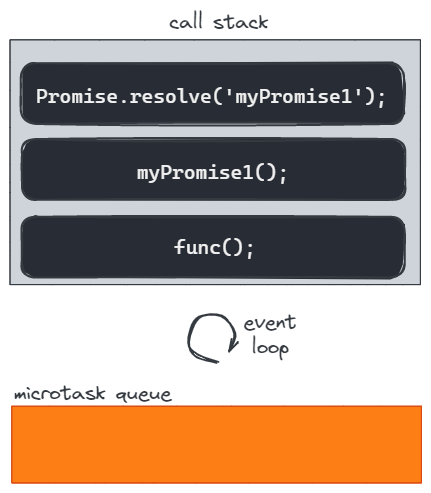
이때, await 키워드를 만나게 되면 async 함수는 해당 부분에서 일시 정지(suspended) 됩니다. 즉 함수가 콜스택으로 부터 제거되어 마이크로태스크 큐 내에서 실행되게 됩니다:
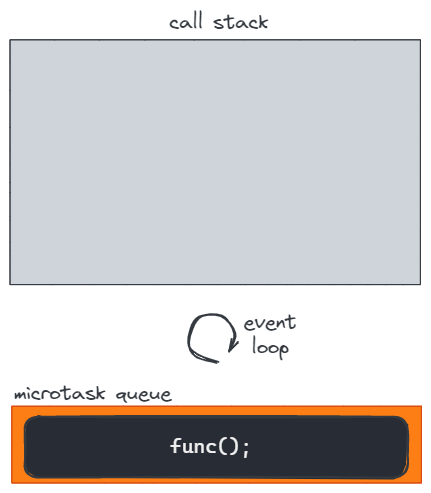
이렇게 되면 해당 async 함수가 콜스택에서 제거되었으므로 제어권이 이전 프레임으로 넘어갑니다. 이 경우 글로벌 실행 컨텍스트가 되겠네요 (만약 방금 일시 정지된 async 함수가 중첩된 함수였다면 이 함수를 호출한 바깥 함수로 제어권이 넘어가게 됩니다). 이렇게 글로벌 실행 컨텍스트로 제어권이 다시 넘어갔기 때문에 이전에 실행되던 부분을 이어서 실행하게 됩니다. 이 경우 console.log('after func');를 실행하겠네요!
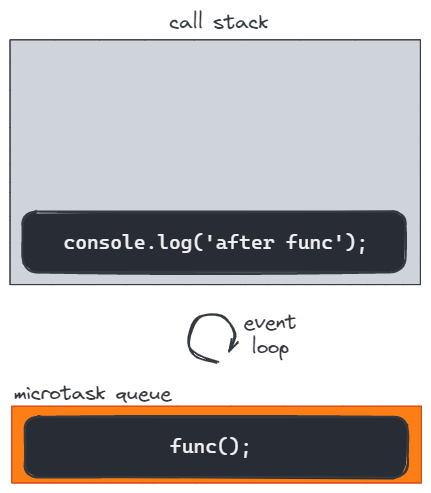
이제 더 이상 콜스택에 남아있는게 없으므로 자바스크립트 엔진은 마이크로태스크 큐에서 대기(queue up)하고 있는 태스크가 있는지 살펴봅니다. 지금은 func()가 기다리고 있던 myPromise1이 resolve된 상태이므로 func()가 마이크로태스크 큐에서 대기(queued up)하고 있습니다. 이를 큐에서 꺼내서 콜스택에 추가하여 실행합니다. 이렇게 되면 func() 함수는 이전에 중단된 지점부터 다시 실행을 이어나가게 되는데, 여기선 myPromise1이 resolve한 값을 받아 res1에 저장하고 console.log(res1);을 실행합니다:
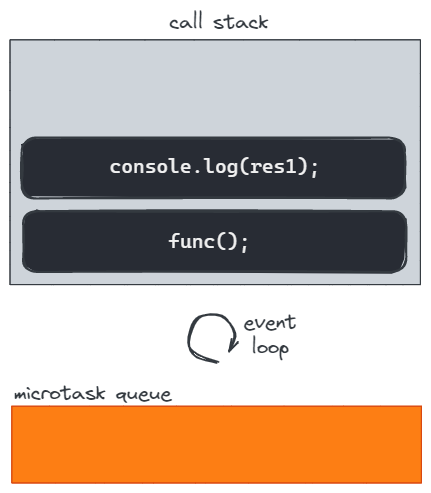
이제 다시 await 키워드를 만나게 되었는데, 앞서 살펴본 것과 동일한 상황이 전개됩니다. myPromise2가 resolve될 때까지 func() 함수는 마이크로태스크 큐로 가서 실행되다가, myPromise2가 resolve되면 대기 상태가 되어 실행되기를 기다리게 됩니다:
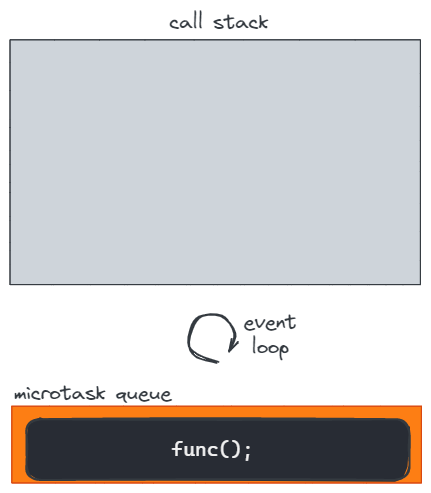
그러다 콜스택이 비면 func()는 다시 콜스택에 추가되어 실행됩니다. 이때도 마찬가지로 myPromise2가 resolve한 값이 res2에 저장되고 console.log(res2);와 console.log('func end')가 실행된 후 최종적으로 func() 함수도 종료됩니다:
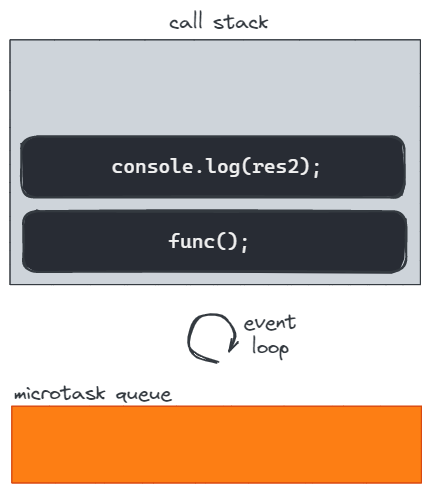
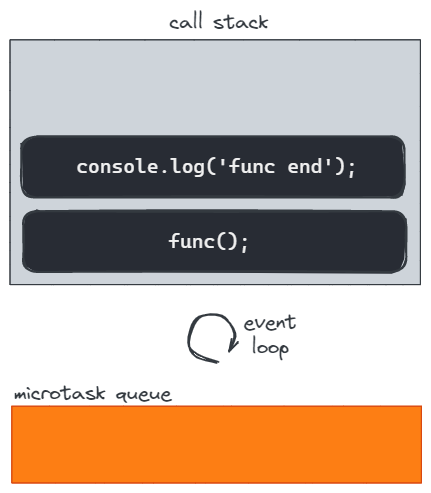
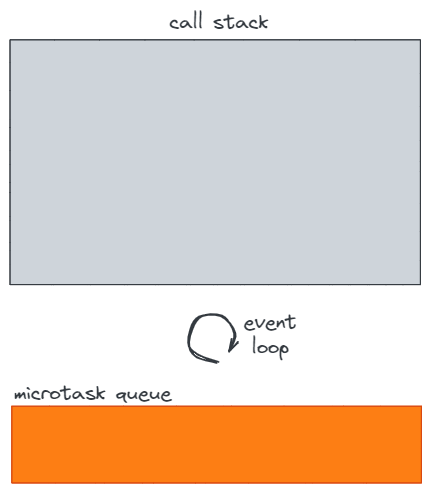
References
JavaScript for impatient programmers (ES2021 edition)
JavaScript Visualized: Promises & Async/Await - Lydia Hallie